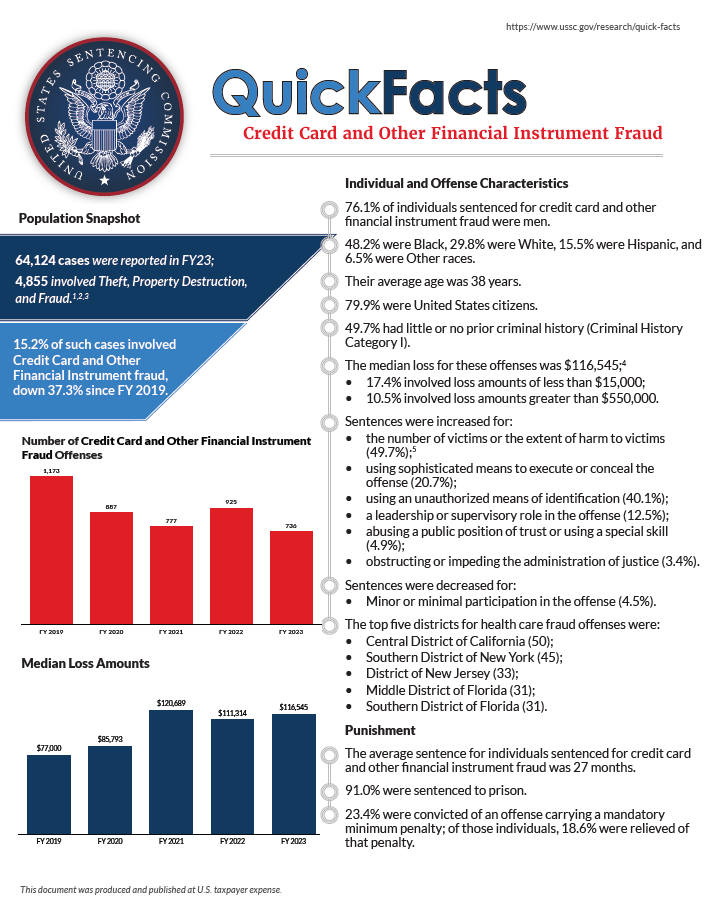Of the 61,678 cases reported to the Commission in fiscal year 2024, 739 involved credit card and other financial instrument fraud. Credit card and other financial instrument fraud offenses have decreased 16.7% since fiscal year 2020.1,2
Click the cover for the PDF handout or learn more below.
Individual and Offense Characteristics
- 74.7% of individuals sentenced for credit card and other financial instrument fraud were men.
- 45.3% were Black, 34.7% were White, 14.0% were Hispanic, and 6.0% were Other races.
- Their average age was 38 years.
- 82.8% were United States citizens.
- 55.5% had little or no prior criminal history (Criminal History Category I).
- The median loss for these offenses was $154,919;3
- 17.1% involved loss amounts of less than $15,000;
- 24.2% involved loss amounts greater than $550,000.
- Sentences were increased for:
- the number of victims or the extent of harm to victims (52.2%);4
- using sophisticated means to execute or conceal the offense (25.4%);
- using an unauthorized means of identification (40.9%);
- a leadership or supervisory role in the offense (10.8%);
- abusing a public position of trust or using a special skill (5.8%);
- obstructing or impeding the administration of justice (3.1%).
- Sentences were decreased for:
- minor or minimal participation in the offense (7.3%).
- minor or minimal participation in the offense (7.3%).
- The top five districts for individuals sentenced for credit card and other financial instrument fraud were:
- Central District of California (49);
- Southern District of New York (45);
- Southern District of Florida (37);
- District of New Jersey (33);
- Northern District of Ohio (24).
Punishment
- The average sentence for individuals sentenced for credit card and other financial instrument fraud was 26 months.
- 92.7% were sentenced to prison.
- 19.1% were convicted of an offense carrying a mandatory minimum penalty; 12.1% of those individuals were relieved of that penalty.
Sentences Relative to the Guideline Range
- 61.4% of sentences for credit card and other financial instrument fraud were under the Guidelines Manual.
- 40.0% were within the guideline range.
- 16.4% were substantial assistance departures.
- The average sentence reduction was 64.0%.
- The average sentence reduction was 64.0%.
- 4.1% were some other downward departure.
- The average sentence reduction was 40.1%.
- The average sentence reduction was 40.1%.
- 40.0% were within the guideline range.
- 38.6% of sentences for credit card and other financial instrument fraud were variances.
- 37.0% were downward variances.
- The average sentence reduction was 49.3%.
- The average sentence reduction was 49.3%.
- 1.6% were upward variances.
- The average sentence increase was 43.9%.
- The average sentence increase was 43.9%.
- 37.0% were downward variances.
- The average guideline minimum and average sentence imposed have remained steady over the past five years.
- The average guideline minimum was 34 months in fiscal year 2020 and 35 months in fiscal year 2024.
- The average sentence imposed was 26 months in fiscal year 2020 and fiscal year 2024.
- The average guideline minimum was 34 months in fiscal year 2020 and 35 months in fiscal year 2024.
1 Credit card and other financial instrument fraud includes cases in which the individual was sentenced under §2B1.1 (Larceny, Embezzlement, and Other Forms of Theft; Offenses Involving Stolen Property; Property Damage or Destruction; Fraud and Deceit; Forgery; Offenses Involving Altered or Counterfeit Instruments Other than Counterfeit Bearer Obligations of the United States) using a Guidelines Manual in effect on November 1, 2001 or later and where the offense conduct as described in the Presentence Report involved fraudulent activity involving credit cards, debit cards, checks, bank accounts, or non-mortgage loans. Prior to fiscal year 2020, credit card fraud was a stand-alone category. Beginning in FY2020, credit card fraud is combined with other offenses involving financial instruments, resulting in a larger category of offenses. Therefore, previous Quick Facts for credit card offenses are not comparable to the category of offenses reported in this publication.
2 Cases with incomplete sentencing information were excluded from the analysis.
3 The Loss Table was amended effective November 1, 2001 and November 1, 2015.
4 The Victims Table and Sophisticated Means adjustment were amended effective November 1, 2015.
5 “Early Disposition Program” (or EDP) departures are departures where the government sought a sentence below the guideline range because the defendant participated in the government’s Early Disposition Program, through which cases are resolved in an expedited manner. See USSG §5K3.1.
SOURCE: United States Sentencing Commission, FY 2020 through FY 2024 Datafiles, USSCFY20-USSCFY24.

